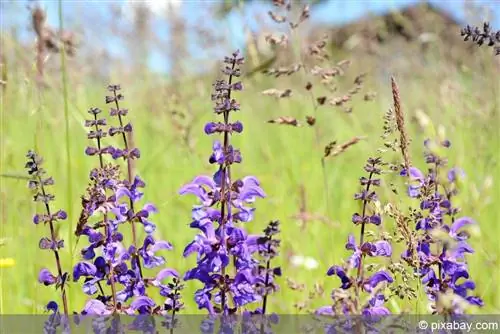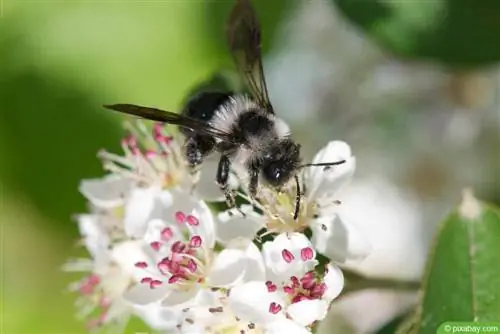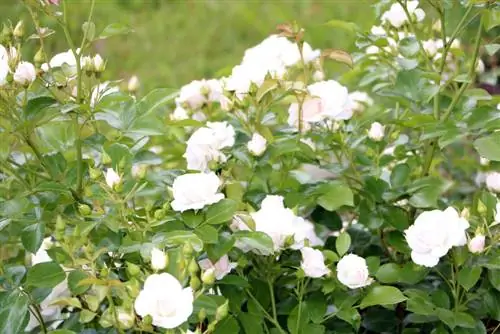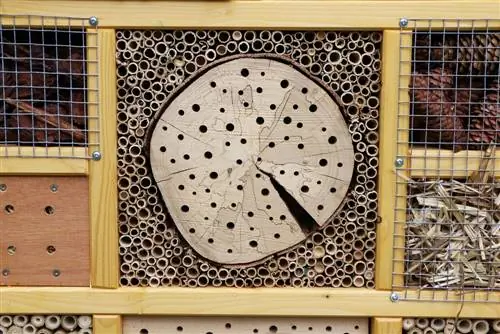- Author admin [email protected].
- Public 2023-12-17 03:39.
- Last modified 2025-01-24 12:45.
Wild herbs grow in many natural locations, they bloom along the side of the road and thrive in meadows and on embankments. With a herb lawn, these useful plants can also be brought into your home garden, bringing a piece of wild nature into your own home. If you prefer specific types of herbs, you should put together your own seed mixture and plant it in the herb meadow.
Create a herb lawn
If you want to create a herb lawn, you can buy the right seeds as a ready-made mixture from specialist retailers. However, if specific wild herbs are to be planted because of their healing or decorative properties, then the seed mixture must be prepared with the desired varieties yourself. If the herb lawn has a homogeneous variety of different types of herbs, then it is significantly less susceptible to pests and weeds. The plants support each other and pests and weeds cannot spread as easily. Wild herbs that come from the local region and prefer the same location conditions are ideal. In this way, the herbs are guaranteed to fit well together and the roots complement each other in the soil, so that he althy soil life is maintained. Herbal lawns are much easier to care for than conventional grass lawns and are much nicer to look at.
- Herb lawns should consist of a variety of different varieties
- A mixture of grasses, herbs and flowers is ideal
- Sowing seeds during the usual growing seasons
- Sowing either in spring or autumn
- First loosen the soil slightly and remove weeds
- Fertilizing is only necessary in extremely nutrient-poor soils
- Wild herbs prefer poor soil qualities with low nutrient content
- Additional watering only during long dry periods
- Use low-lime rainwater for watering
- Keep herb seeds moist for about 2-3 weeks before sowing
- This supports germination
- It is optimal to cut grass before winter
- Pruning has a positive effect on the growth of the herbs
- However, regular mowing of the lawn is not necessary
Field thyme
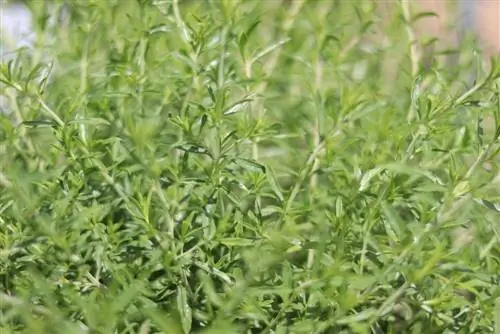
The wild thyme has the botanical name Thymus serpyllum and belongs to the mint family. The plant enchants with aromatic, fragrant flowers that produce lots of nectar and are an important source of food for pollinating insects. The plant spreads quickly and forms dense, carpet-like mats in the herb lawn. These are still green even in winter and are an attractive eye-catcher in contrast to the rest of the wintry brown garden. Due to the essential oils, tannins and bitter substances contained in field thyme, it is used as a medicinal plant. However, the leaves of the wild thyme variety are less aromatic than the cultivated forms.
- Robust and perennial ground cover
- Extremely hardy down to -20° C
- Flowering period between June and August
- Flowers are pink to light purple
- Forms fine, smooth and gray-green leaves
- Creeping growth habit and short growth
- Prefers sunny locations
- Permeable and dry soil properties are ideal
- Loosen compacted and clayey soils with sand
- Only water additionally during long periods of drought
- Pruning in spring stimulates dense growth
Broom Heath
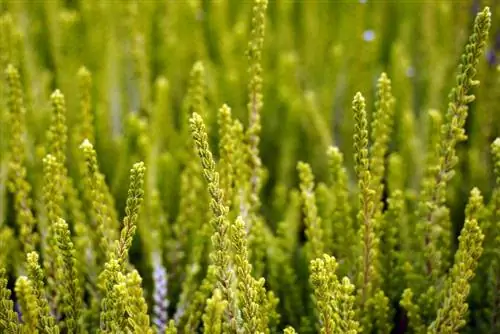
The common heather has the botanical name Calluna vulgaris and belongs to the heather family. In some regions this is also known as summer heath. The plant grows into a small bush that branches out over time. This is why it is ideal as an edging for the outer areas of the herb lawn. However, common heather grows relatively slowly, but can live for many years. The heather shines in many different flower colors and is a beautiful addition to the summer-flowering wild herbs, as they only bloom from late summer to the end of autumn. This is why common heather is a welcome source of food for pollinating insects in autumn, especially bees and butterflies.
- Prefers sunny locations
- Bright partial shade is also possible
- Stony to sandy soil qualities are ideal
- Grows well in dry to moderately moist soils
- Varied flower colors: yellow, orange, red, pink, violet and white
- Flowering period from the end of August to November
- Forms evergreen and scale-like leaves
- Leaves are relatively small, leathery and curled upwards
- Perennial plant with extremely good winter hardiness
- Relatively undemanding in terms of care
- Only water additionally during long periods of drought
- Avoid waterlogging at all costs
woman's coat
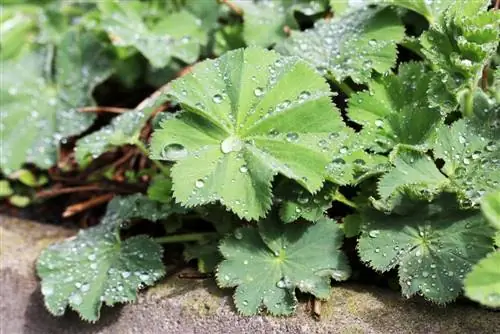
The lady's mantle has the botanical name Alchemilla vulgaris and belongs to the rose family. Its Latin name comes from the experiments in the mysterious world of alchemy. As a wild herb, it has spread in many countries from Europe to Asia; it has become known primarily for its bright inflorescences and its healing properties. Thanks to this flower, the plant is an enchanting addition to the home herb lawn. The plant is also known as autumn coat, lion's foot herb and lady's herb. There are now hundreds of different species, but they are very difficult to differentiate. Various healing powers are attributed to the lady's mantle and it has been used in folk medicine since ancient times.
- Sunny to partially shaded location is ideal
- Frugal plant, does not require much care
- Adapts well to existing site conditions
- Perennial plant, but only partially hardy
- Needs additional winter protection at altitudes
- Blooms between May and September in a bright yellow
- After flowering, small nut-like fruits are formed
- Forms heavily woody roots
- Does not tolerate extreme periods of drought or intense heat
- Water additionally during long dry periods
- Contains bitter substances, tannins, glycosides and phytosterol
St. John's Wort
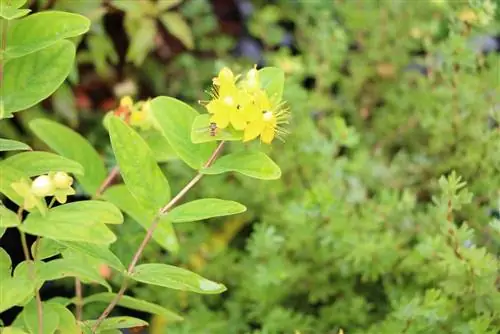
St. John's wort has the botanical name Hypericum perforatum and has been valued as a medicinal plant since ancient times. The wild herb has now spread almost all over the world and can be found primarily along roadsides and in sparse forests. Its other names include Walpurgis herb and Solstice herb, which refer to the beginning of the plant's flowering period. This usually begins around St. John's Day on June 24th. Traditionally, St. John's wort is a symbol of light and the sun. It is used to make wreaths and bouquets worn on the occasion of the summer solstice. The wild herb brightens the mood and has a calming effect; it helps with nervousness, insomnia and can relieve anxiety.
- Sunny location conditions are ideal
- Undemanding and persistent plant, well hardy
- Prefers dry and calcareous soils
- Loosen extremely compacted and clayey soil with sand
- Bright golden yellow flower color
- Flowering time is from June to August
- Forms green and elongated pointed leaves
- Roots are branched and spindle-shaped, with flat runners
- Forms an egg-shaped capsule as a fruit
- Requires additional watering during longer dry periods
Yarrow
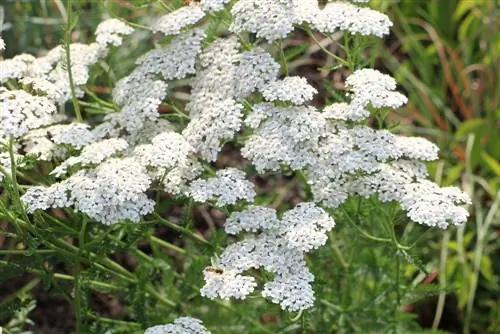
Yarrow has the botanical name Achillea and belongs to the daisy family. It grows as a wild herb in many meadows in the local latitudes. Thanks to its healing properties, the plant has become firmly established in folk medicine. This plant is also known colloquially as Achilles herb because the Greek hero used it to treat and heal his own wounds. In German usage, yarrow is also known as stomach ache herb because it is used for women's ailments and digestive problems. It also has a blood-purifying, diuretic and anti-inflammatory effect. From June onwards, the upper two thirds of the flowering herb can be harvested and can be further processed into bath additives, teas and tinctures. However, caution is advised when using it for the first time as yarrow can cause allergies.
- Widespread meadow weed, hardy and perennial
- Easy to care for and undemanding plant
- Prefers sunny and warm locations
- Needs loose and permeable soil
- Tolerates prolonged drought relatively well
- Can't handle waterlogging at all
- Low-growing species are ideal for herb lawns
- Produces umbel-shaped and white flowers
- Helps heal wounds
- Supports circulation and relieves cramps
Ribwort Plantain

The ribwort plantain is listed in botany as Plantago lanceolata and belongs to the plantain family. The plant is also colloquially referred to as field herb, medicinal plantain and sheep's tongue. The perennial plant has spread worldwide and grows wild in fields, meadows, pastures, along paths and field edges. The ribwort plantain can sometimes also be found in parks. The more nutrient-rich the soil, the higher the wild weeds grow. Its healing effects have been known since ancient times and were also valued in monastery medicine. In addition, the ribwort plantain can also be used to prepare salads.
- Robust and perennial plant
- A sunny and warm location is ideal
- Prefers deep and nutrient-rich soil qualities
- Soil should be sandy and rather dry
- Grows like a herb and forms angular stems
- Leaves climb upright
- Rootstock can grow deep, with fine fibrous roots
- Flowering time is between May and September
- Flowers are inconspicuous with brown-white coloring
- Wild herbs are very undemanding when it comes to care
- It is important to prune in the summer after flowering
- This stimulates new growth of fresh leaves
Meadow sage
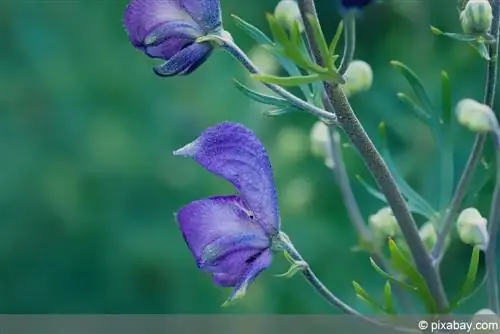
The meadow sage has the botanical name Salvia pratensis and belongs to the plant family Lamiaceae. This wild form of the native sage genus is a perennial plant that can reach shrub-like dimensions. In many regions, meadow sage grows on fallow land, along the edges of paths and in meadows. Anyone who spots this plant on a walk can collect the seeds directly from the naturally occurring plants. Due to the abundant flowers, the plant serves as a food source for bees, bumblebees and butterflies. In this way, meadow sage makes a lasting contribution to the ecological balance in nature. In addition, meadow sage can be used as a spice and medicinal plant.
- Hardy and perennial plant
- Prefers dry and sunny locations
- Loosen the soil well before sowing
- Mix compacted soil with sand
- Scatter seeds occasionally between other types of herbs
- Water additionally if dry conditions persist
- There should be no waterlogging
- Makes little demands on care
- Enchanted with blue flower candles
- Flowering period is long and lasts from May to August
- Forms split fruits in July and August
- Spicy leaves are edible
- The shoot tips are especially delicious

